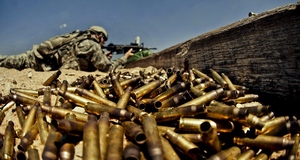The Military-Industrial Complex in the United States: Evolution and Expansion from World War II to the War on Terror
By
2013, Vol. 5 No. 08 | pg. 1/1
IN THIS ARTICLE
After World War II, the United States military gradually came into a position of overwhelming dominance in the world. Military spending in the United States far outpaces that of other countries, with their world share of military expenditures at 41% in 2011, followed by Russia and China with only eight and four percent respectively (SIPRI 2012). This has been the case since the Second World War and has been justified in different ways over time. The arguments for continued military dominance have ranged from “long-term economic gains” at the start of the war (Shoup and Murray 1977, cited in Hossein-zadeh 2006: 45) to Soviet containment during the Cold War, “a broader responsibility of global militarism” since the 1980s (Ryan 1991, cited in Hossein-zadeh 2006: 73), and most recently the need to protect citizens against Islamic fundamentalism and terrorist attacks. Nevertheless, there has been consistent concern that powerful groups in military, political, and corporate positions, profiteering from conflict and sharing interests in intensifying defense expenditure, have become the primary actors for making and administering U.S. foreign policy. Today the scope of the defense industry is now much bigger than legitimate security needs justify (see, for example, Moskos 1974, Mintz 1985, Waddell 2001 and Hossein-zadeh 2006). This analysis argues that expansion of the U.S. military establishment from the 1940s onward was initially a means to an end in the process of stabilizing the world economy and serving national security interests, but -- over time -- became an end in itself, serving the interests of an elite group that uses the projection of power as a way to justify the continued expansion of military spending. This essay is divided into two sections: the first focuses on the origins of America’s military-industrial complex, beginning with a definition of the elite group that the complex comprises. Next, by focusing on the period in which the foundation for the complex was laid – the Second World War – it is argued that the complex arose unintentionally in some ways, although important characteristics of it were visible from the start. Third, military Keynesianism, often used to defend high military budgets once the complex was in place, will be discussed and refuted. The second section focuses on the most important argument in favor of high military budgets today: the need to protect American citizens from the global threat of terrorism. It is argued that public perceptions of the causes of terrorism are incorrect, yet have been gladly utilized and fostered by the American military-industrial complex to justify an ineffective global war. The Evolving Military-Industrial Complex in the United StatesWhat distinguishes the “power elite” that constitutes the military-industrial complex from other powerful groups in American society who also seek advancement of their own interests, is that this is not a ruling class based solely on the ownership of property (Mills 1956, cited in Moskos 1974: 499-500). Rather, it is a coalition of civilian agencies that formally shape military policy (such as the Senate and the CIA), military institutions, private firms, research institutions and think tanks – all centered on and linked to the Pentagon (Hossein-zadeh 2006: 13). As a result of power arising from the occupancy in top bureaucratic positions as well as from capital ownership, the interests of the ruling elite go beyond the mere accumulation of wealth and include desires to maintain themselves in power and to press for specific forms of public policy. Their most important common interest is intensifying defense expenditure. War profiteering in itself is not new – wars have always been fought at least in part for economic gains. Today’s military-industrial complex is different in that it treats war as a business: the ruling elite’s goal of having a large military establishment is not to expand the nation’s wealth, but “to appropriate the lion’s share of existing wealth for the military establishment” (Hossein-zadeh 2006: 90). As a consequence, decisions on defense allocation, arms production and military operations are motivated by desires for profit and personal power, not necessarily by security requirements.This is not to say that expansion of the military budget has always been an ‘end’ for a powerful group of elites, but in fact was initially a means to serve other ends. The first big expansion of the military establishment took place in the early years of the Second World War, when the U.S. had legitimate concerns for its own national security due to such events as the attack on Pearl Harbor, and feared the war would negatively impact foreign trade. Military expansion is a logical result of the former concern, as it is a means to preserve physical security. However, it is closely linked to the latter concern, too. The Council on Foreign Relations, one of the nation’s most influential think foreign policy think-tanks, advised the U.S. government that it needed free access to markets and raw materials in all regions outside of continental Europe for economic self-sufficiency. To this end, the U.S. advocated globalization and open economic cooperation through multilateralism. At the time, the crisis of the ‘30s and the war had made the concept of the free market highly unpopular. This made “military supremacy for the U.S. within the non-German world” a complementary requirement to ensure all countries within the “U.S.-led, non-German Grand Area,” including Japan, would accept American conditions (Shoup and Murray 1977, cited in Hossein-zadeh 2006: 45). In short, military spending was not yet an end in itself, it was the combined result of needing to increase power in the face of security challenges and wanting to restore trust in and stabilize the global capitalist system. Key characteristics of the current military-industrial complex, however, were already present when the objectives of U.S. foreign policy during World War II were drafted. As Hossein-zadeh points out, a brief look at the social status and class composition of the Council on Foreign Relations, which consisted of wealthy, influential people with ties to major industrial corporations and politicians, shows that a ruling class shaped major government policies “operating through the institutional umbrella of the Council, and providing intellectual justification for major foreign policy overhauls” (2006: 41). The military-industrial complex in its present form might not have been in place then or have been created intentionally, but clearly there already was a power elite based on more than capital ownership, and strong ties between the military, political, and corporate spheres. After World War II, the Cold War stabilized U.S. foreign policy for over forty years1. With its demise, a “vacuum in the organizing principles of national government” had emerged (Waddell 2001: 133). Even if unintended, the military-industrial complex was well in place by now, and suggestions to curtail the military budget were met with fierce opposition. However, cutting back on non-military public expenditures while an expensive military establishment is preserved proved harder to justify with the loss of the perceived Soviet threat. An argument in favor of military spending that has been used consistently is that it boosts economic growth (Dreze 2000: 180). Mintz, for instance, notes that the military-industrial complex is seen by many to have “considerable influence on levels of employment, … the profitability of arms manufacture and the scope of exports” (1983: 124). The view that large military spending is an effective means of demand stimulation and job creation, and hence of economic growth, is called military Keynesianism. Keynes’ (non-military) theory holds that in times of inadequate purchasing power, the (non-military) private sector becomes wary of expansion, and so the government should spend money in order to boost the stagnant economy by stimulating demand. Since expansion of the military industry is a government investment, it could have the desired economic effects in times of recession. However, it is important to keep in mind that Keynes argues for little government spending in times of high employment and sufficient demand. Military Keynesianists seem to ignore this fact completely and have argued for high government expenditures even during the Golden Age after World War II – and in no other sector than the military-industrial one. This can only be explained by the fact that it is a constantly shrinking number of people experiencing the economic benefits of high military spending (Waddell 2001: 135). The same people tend to switch positions between the Pentagon, its prime contractors and lobbying think tanks supporting those contractors, meaning that military spending is no longer an economic stimulus for the entire nation. Instead, it has become a redistributive mechanism of national resources in favor of the wealthy (Hossein-zadeh 2006: 226). Cashing In on the War on TerrorWhat gets lots in the debate over the economic consequences of military spending is the effect it has on international stability. An old principle asserts that military threats are essential in preventing wars from occurring (Dreze 2000: 1178), but an overly extended military establishment means actual military operations are necessary from time to time to ‘prove’ the necessity of the army. And indeed, militarists have found that the most effective manner of convincing the American public of the need of a large military establishment is the constant ‘discovery’ of external threats. The threat currently most emphasized by the U.S. is global terrorism. We argue that while some fears of Islamic fundamentalism are justified, most are not; and that the threat of terrorism is not logically followed by higher military investment. The U.S. is not being fair in its assessment of the Arab threat. Public discourse today implies that Islam is inherently more rigid and anti-modern than other religions. Huntington famously predicted that most major conflicts would be between Muslims and non-Muslims, as “Islam has bloody borders” (1993: 12). In 1990, historian Bernard Lewis described a “surge of hatred” rising from the Islamic world that “becomes a rejection of Western civilisation as such” (cited in Coll 2012). Richard Perle, American neoconservative militarist and advisor to Israel’s Likud Party, proposes a strategy of “de-contextualization” to explain acts of terrorism and violent resistance to occupation, arguing that we must stop trying to understand the territorial, geopolitical and historical reasons that some groups turn to fundamentalism; instead, reasons for the violence of such groups must be sought in the Islamic way of thinking (Hossein-zadeh 2006: 101). Religious fundamentalism, however, is universal: it arises in response to modernity and secularism, both of which tend to weaken or threaten religious traditions. John Voll points out that by the early 1990s, “violent militancy was clearly manifest among Hindu fundamentalists, Buddhists in Sri Lanka, Jewish fundamentalists in Israel and others elsewhere” (1994, cited in Hossein-zadeh 2006: 110-11). As one scholar points out, if the Bosnians, the Palestinians and the Kashmiris are asked about their borders they would say that, respectively, Christianity, Judaism and Hinduism are the ones that have bloody borders (Ahmed 2002: 29). Yet statements like the ones by Huntington, Lewis and Perle cited above single out Islam as the most dangerous potential enemy of the West. They all interpret the militancy of Islamic fundamentalism as being somehow directly caused by distinctive Islamic doctrines and traditions (Voll 1994, cited in Hossein-zadeh 2006: 111) and attribute terrorist attacks to “pathological problems of the Muslim mind” (Hossein-zadeh 2006: 101). In doing so, they posit a characteristic supposedly shared by Muslims from Indonesia through Iran to Senegal, that makes conflict with the West inevitable. An incorrect assessment of the roots of terrorism does not justify the extent to which the U.S. expanded its military activity after 2001; nor does it explain why it continues to fight an ineffective war. As Peña points out, a larger military would not have prevented the tragedy of 9/11, and it will not prevent future terrorist actions (2001, cited in Snider 2004). Terrorism, much like the war that is fought against it, is a means of pursuing objectives, not an actor. It cannot be stopped by military action as fighting does nothing to address the issues that terrorists feel can only be resolved violently; if anything, this is more likely to lead to a vicious cycle of constantly growing military budgets and an ever higher number of terrorist attacks. As one author put it: “the moral crusade to end terrorism can only begin with a realistic assessment of its cause” (Snider 2004). So far, the global war on terror has done little to eradicate terrorism. On the contrary, it seems the threat of an attack is now bigger: the number of terrorist attacks worldwide has increased from just over 1800 in 2001, to a staggering five-thousand ten years later (START 2012). The question that arises, then, is why successive U.S. administrations have found it so difficult to accept that perhaps their assessment of the causes of terrorism is incorrect; that perhaps, the policies built on their premises are not effective, but rather a self-fulfilling prophecy, leading to a vicious cycle of constantly expanding military activities and an increasing number of individuals who believe their grievances cannot be settled non-violently. This has everything to do with the never-ending need for militarism: 9/11 was approached by the U.S. as an opportunity for aggression. The attacks, however heinous, were approached by the government not as crimes (which would require criminal prosecution and law enforcement), but as a personal attack against Americans (Hossein-zadeh 2006: 91). With the views expressed by Huntington, Lewis and Perle widespread among the American public already, pre-emptive war and military expansion was easily justifiable to Americans. After all, how would dialogue help if the Muslim mind is pathologically troubled? An American citizen might cringe at the idea, but it is true: the 9/11 tragedy “came from heaven to an administration determined to ramp up military budgets” (Johnson 2004: 64). ConclusionThis essay has sought to argue that the U.S. military-industrial complex was the unintentional result of both a desire to stabilize the global capitalist system and to protect national security interests, but that military spending is now closely linked to the personal interests of a small, influential group of elites. In the first section, it was illustrated that the context of the Second World War made increased military expenditures a necessary means to other ends, although the power elite that would eventually come to benefit from these expenditures was already in place. Once in place, this power elite has constantly needed to justify the disproportionate allocation of national resources to the military establishment. Emphasizing the economic benefits of military investment by drawing on Keynesian theory is a way of doing so, but military Keynesianists seem to give a one-sided account of the theory, one that suits their interests. The second section focused on the global war on terror, arguing that the U.S. is capitalizing on public fears which are based on an incorrect assessment of the causes of terrorism. The war on terror has done little to eradicate terrorism, but as long as the public continues believing it is a necessary war, the U.S. military-industrial complex will continue using it as an opportunity to keep military budgets high. ReferencesAhmed, A. (2002) ‘Ibn Khaldun’s understanding of civilizations and the dilemmas of Islam and the West today’, Middle East Journal, Vol. 56, No. 1, pp. 20-45 Coll, S. (2012) ‘Days of Rage’, The New Yorker, 1 October. [Online] Available at http://www.newyorker.com/talk/comment/2012/10/01/121001taco_talk_coll (accessed 7 January 2013) Dreze, J. (2000) ‘Militarism, development and democracy’, Economic and Political Weekly, Vol. 35, No. 14, pp. 1171-1183 Hossein-zadeh, I. (2006). The political economy of U.S. militarism. New York: Palgrave Macmillan Huntington, S. P. (1993) ‘The Clash of Civilizations?’ in The Council on Foreign Relations, ed. 1996, Samuel P. Huntington’s the clash of civilizations: the debate, New York: Council on Foreign Relations, pp. 1-26 Johnson, C. (2004) The sorrows of empire: militarism, secrecy, and the end of the republic. New York: Henry Holt and Company Mintz, A. (1985) ‘The military-industrial complex: American concepts and Israeli realities’, The Journal of Conflict Resolution, Vol. 29, No. 4, pp. 623-639 Moskos, C. (1974) ‘The concept of the military-industrial complex: radical critique or liberal bogey?’, Social Problems, Vol. 21, No. 4, pp. 498-512 SIPRI (Stockholm International Peace Research Institute) (2012) Military spending and armament: the 15 major spender countries in 2011 (table). Solna: SIPRI. Available at http://www.sipri.org/research/armaments/milex/resultoutput/milex_15 (accessed 4 January 2013) Snider, B. (2004) ‘Manufacturing terrorism’, antiwar.com, 14 June. [Online] Available at http://antiwar.com/blog/2004/06/14/manufacturing-terrorism/ (accessed 6 January 2013) START (National Consortium for the Study of Terrorism and Responses to Terrorism). (2012) Incidents over time. Maryland: Global Terrorism Database. [Data file] Available at http://www.start.umd.edu/gtd/search/Results.aspx?region= (accessed 7 January 2013) Waddell, B. (2001) ‘Limiting national interventionism in the United States: the warfare-welfare state as a restrictive government paradigm’, Capital and class, Vol. 74, pp. 109-140 1.) The U.S. did have to rethink the expenses of their policies during the crisis of the ‘70s, when expanding on both warfare and welfare became too expensive. Allocating taxpayers’ money to the military had become harder to justify for several reasons; by this time, however, the military-industrial complex was well in place. Beneficiaries of militarism succeeded in maintaining high military budgets, mainly by exaggerating the ‘Soviet threat’ (such as in the now-discredited Team B report by the Committee on the Present Danger). This was clearly a way of defining the elite group’s interests in terms of national interests and is relevant to the topic, but it is not within the scope of the essay to discuss this in detail. Suggested Reading from Inquiries Journal
Inquiries Journal provides undergraduate and graduate students around the world a platform for the wide dissemination of academic work over a range of core disciplines. Representing the work of students from hundreds of institutions around the globe, Inquiries Journal's large database of academic articles is completely free. Learn more | Blog | Submit Latest in International Affairs |
















